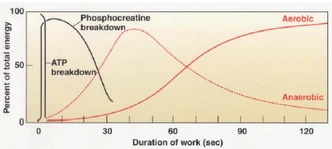Lecture Details[]
Wayne Sturrock; Week 5 MED1022; Physiology
Lecture Content[]
1) Immediate energy pathway has direct phosphorylation of ADP from creatine phosphate; catalysed by creatine kinase. Creatine phosphate + ADP -(creatine kinase)-> ATP + creatine. Is very fast but limited by store of creatine. It is a short term buffer for ATP production. No net ATP production. Stops after about 30 seconds.

2) Anaerobic energy pathway uses glycolysis, occurs in the cytoplasm, is relatively inefficient (2 ATP from 1 glucose), requires glucose as a fuel, very fast, can proceed without oxygen (lactic acid is produced). Peaks at about 40 seconds.
3) Aerobic energy pathway has ATP production from oxidative phosphorylation in the mitochondria, 38 ATP for 1 glucose, relatively slow, requires continous supply of oxygen and substrates. Can use carbohydrate, fats or protein in extreme circumstances. After about 60 seconds this pathway takes over, peaks at 2 minutes.
Fats are primary fuel in low intensity exercise; carbs in high intensity. Balance between usage determined by duration and intensity of exercise and nutritional status of individual. Time to exhaustion is directly related to muscle glycogen content which is dependant on diet. High carb diet increases these stores. Skeletal muscles can be divided by speed of contraction and metabolic pattern; slow are type I and fast are type II; fast oxidative are IIA and fast glycolytic are IIB. Oxidative fibres have a smaller diameter, they have the most capillaries, more mitochodria.
IIB used for rapid, powerful movements. IIA for relatively fast movements with medium endurance. I have prolonged contractile activity with high endurance (posture). Limb muscles mainly type II, postural mainly I. All muscle fibres of the same motor unit are the same type because the nerve supplying determines the type of myosin in the fibre.
Muscle fatigue is decrease in generating force during prolonged activity. Rate varies for different fibres, IIB fatigue most rapidly, I are resistant, IIA are moderately resistant. Muscle fatigue can be due to failure of SR Ca release, inhibition of crossbridge activation from lactic acid pH imbalance or buildup of inorganic phosphate. Muscle performance is related to power output (muscle strength and speed of contraction) and endurance (muscle metabolic capacity, increasing oxidative capacity increases). Muscle fibres can change in size and metabolic capacity; can be induced in response to patterns of use and activity. A slow fibre cannot turn into a fast one but transition between type II fibres is possible (genetically determined mainly). Endurance training increases mitochondria, concentration of oxidative enzymes increase, capillaries increase. Strength training changes IIA to IIB, hypertrophies muscle fibres due to increased muscle fibre synthesis of contractile proteins and myofibrils. There is no increase in number, turnover just increases. Testosterone promotes actin/myosin synthesis.
Sarcopenia is different to atrophy- is age related decrease in muscle mass or strength. Contributes to decline in physical function, increased disability/frailty, loss of independance and increased risk of falls.